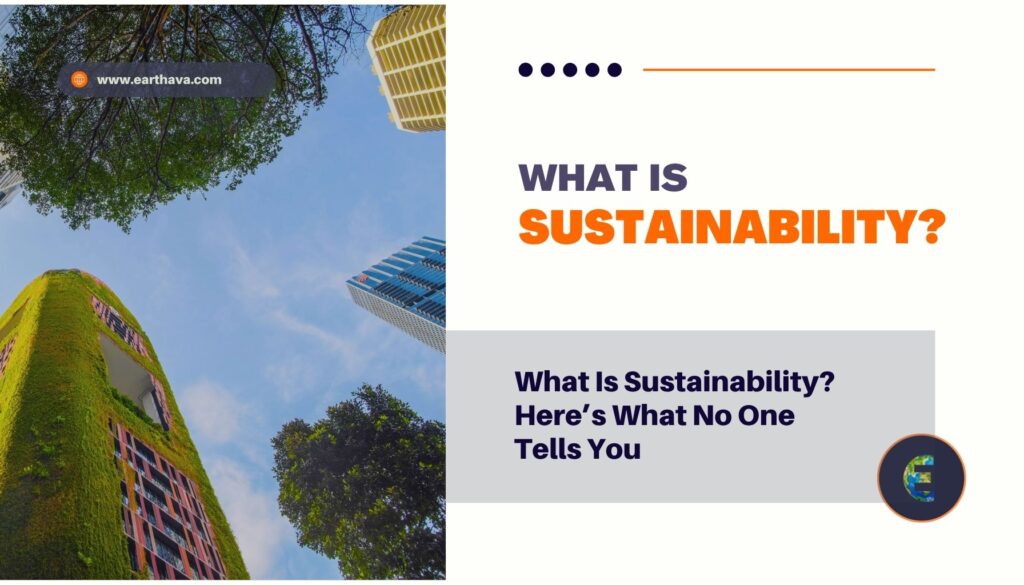What Is Sustainability? Sustainability means meeting our current needs without compromising the ability of future generations to meet theirs. It’s about balance, between people, planet, and profits.

Sustainability, nowadays, is one of the most pronounced words we hear every day, but what is it in particular?
What Is Sustainability?
This term has been commonly defined as the development model capable of ensuring the satisfaction of the needs of the present generation without compromising the possibility of future generations realizing their own.
Being sustainable does not just mean being respectful of the environment; it means that what you are doing, whatever it is, is something durable in the future, respectful for the people around you, and accessible.
To achieve sustainable development of human societies, it is necessary that:
• human intervention is limited within the carrying capacity of natural systems while preserving their vitality and resilience;
• Technological progress for the production of goods and services is directed towards increasing efficiency rather than increasing the flow of energy and raw materials.
• the levels of withdrawal of non-renewable resources exceed their regenerative capacities;
• The emission of scraps and waste (solid, liquid, and gaseous) due to the metabolism of social systems does not exceed the assimilation capacity of natural systems.
The History Of Sustainability
Since the dawn of the history of modern economic thought, economists have been concerned about the scarcity of some of the factors of production, especially arable land, and the possibility that economic growth would stop. Classical economists were aware that the availability of natural resources could be a limiting factor in economic growth.
Both Adam Smith (1723-1790) and Malthus (1766-1834) took up the idea that the scarcity of natural resources can be an obstacle to growth, underlining the limitation of natural resources in the face of an ever-increasing population.
They took into account natural limits and in particular, arable land, ending up writing that demographic growth involves a decline in capital and production and consequently in economic growth: not everyone will be able to have their “banquet de la nature”. It is easy to see how close it already was to an absolutely current and modern vision of equity, at least at an intergenerational level, of development represented by equal access to the “banquet de la nature” and, therefore, to a “portion” of natural resources.
An identical conclusion was announced by the Club of Rome when, in 1972, the report “The Limits to Growth” was published, on the hypothesis of an exponential increase in the population, industrial production, and exploitation of the planet’s natural resources, heralding the end of growth as the only remedy.
The golden period of the concept of “zero growth” as a goal for humanity was very short, in fact, following the two oil shocks (1974 and 1979) and the economic recession, most countries experienced a period of economic growth at a level actually close to zero, characterized by high inflation, under-employment, and overall increasing pollution levels.
The Three Main Aspects
Therefore sustainability refers to the environmental, economic, and social fields, the main characteristic in fact is the process of change in which the exploitation of resources, the investment plan, the orientation of technological development, and institutional changes are all in harmony and enhance the current and future potential in order to meet human needs and aspirations.
Sustainable development, first introduced in 1987 by the Bruntland Report of the World Commission for Environment and Development, means development aimed at satisfying the needs of the present generation without compromising the ability of future generations to meet their own needs, which can then be satisfied through a circular and sustainable approach, but what are these three aspects about in detail? Let’s see it together.
Environment
First of all, sustainability refers to the respect for the environment. Nowadays, it is taken for granted, but our cities strictly depend on the quality of the environment in which they are built, so our well-being all depends on the surrounding natural areas in which we live. Sustainability aims to improve our everyday well-being by reducing the polluting emissions of our activities, thus respecting the environment, minimizing waste consumption, favoring the recycling processes, and enhancing the natural areas in our cities in order to maximize the air quality and amount of oxygen we can breathe.
Economy
Sustainability can’t be only considered as an approach to the environment, or just as a form of respect for the ecosystem, the flora, and the fauna, but also and above all as a method for exponentially increasing the quality of life of individuals and the whole society, generating economic sustainability and therefore a more concrete and efficient monetary profit than the current one. Obtaining a high social sustainability through a more transparent and collaborative coexistence within the community.
This is not a model that just supports the current linear economy, but that replaces it entirely at every stage of the production process, regenerating and positively modifying its structure. Re-use, reduce, and re-cycle are among the most important rules of sustainability, a process that aims to reduce the useless and dangerous costs of disposable materials and fossil fuels. Just imagine not paying energy bills anymore because all the electricity you need is provided by solar energy through photovoltaic panels.
Society
Sustainability is an approach that includes, above all, the citizens themselves. In fact, the “circle” of this model begins when everyday practices are implemented by the citizens. A trivial example is its separate collection: the better it is performed inside domestic homes, the better it will be possible to start a circular production process without hitches and additional costs.
The gestures of daily life significantly determine the environmental impact generated by each individual (in the USA, a citizen produces about 25.9 tons of carbon dioxide in a year). For this reason, an improvement from this point of view of daily activities by individual citizens can significantly increase civic education and awareness of environmental respect, just think about the approximately 11,500 tons of chewing gum per Nation thrown on the ground every year, or about the consumption between 9 and 10 billion annual of plastic bags.
A sustainable approach would in addition, favor the so-called Collaborative Economy, improving the reciprocal help between companies and citizens, in order to reduce both CO2 emissions and their relative costs.
When talking about sustainability, it is fundamental to mention the so-called Circular Economy, the best way to concretely apply sustainable practices. Nowadays, our development system is based on the so-called Linear Economy, which exploits natural resources (mostly fossils) to generate goods and services, closing its production process with the elimination of waste, destined to accumulate more and more.
On the other hand, a Circular Economy aims to reduce most of the waste, converting it into an available resource that can be reused as a secondary raw material in the production process, binding economic, social, and environmental fields through the principles of sustainability. Every product or output, from the moment it is manufactured to the moment of its actual use, is optimized until the end of its life cycle.
In this way, it is possible to recover and reuse all (or almost) the waste material as a starting point in another production chain. Circular Economy, in fact, aims to eliminate waste through a better structure and a more efficient design of materials, products, systems, and even business models, adding value and quality to the production process.
The Sustainable Development Goals (SDGs)
The concept of sustainability has developed so fast in the past years that it was quickly recognized as one of the main aspects to take into account for countries all over the world.
The 17 Sustainable Development Goals (SDGs) and the 169 sub-goals associated with them constitute the vital core of the 2030 Agenda. They take into account in a balanced way the three dimensions of sustainable development. For the first time, a single policy document brings together sustainable development and the fight against poverty.
The Sustainable Development Goals must be achieved by 2030 globally by all UN member countries. This means that every country on the planet is called to make its contribution to jointly tackle these great challenges. In addition, incentives will have to be found to encourage non-governmental interlocutors to participate more actively in sustainable development.
Here is the list of the main 17 objectives, as defined by the UN:
1. Eradicate poverty in all its forms and everywhere in the World
2. End hunger, achieve food security, improve nutrition, and promote sustainable agriculture
3. Ensure a healthy life and promote the well-being of all at all ages
4. Ensure inclusive and equitable quality education and promote lifelong learning opportunities for all
5. Achieve gender equality and self-determination for all women and girls
6. Ensure the availability and sustainable management of water and sanitation for all
7. Ensuring access to energy at an affordable, reliable, sustainable, and modern price for all
8. Promote sustained, inclusive, and sustainable economic growth, full employment, and decent work for all
9. Building a resilient infrastructure, promoting inclusive and sustainable industrialization, and supporting innovation
10. Reduce inequalities within and between countries
11. Making cities and human settlements inclusive, safe, resilient, and sustainable
12. Ensure sustainable consumption and production patterns
13 Take urgent measures to combat climate change and its consequences
14. Conserve and sustainably use the oceans, seas, and marine resources
15. Protect, restore, and promote the sustainable use of terrestrial ecosystems, manage forests sustainably, combat desertification, stop and reverse soil degradation, and stop the loss of biodiversity
16. Promote peaceful and inclusive societies oriented towards sustainable development, guarantee access to justice for all, and build effective, responsible, and inclusive institutions at all levels
17. Strengthen the means of implementation and revive the global partnership for sustainable development
The Future Of Sustainability
To understand the problem we are facing with the nowadays development system, we can easily think about this: in Europe, 64.4 million tons of plastic are produced every year, which in total have a value of 355 billion euros, and of which only a third is recycled.
This entails very high disposal costs; just think that at the European level, the only cost for cleaning the beaches is 630 million euros, while at the global level, we reach 13 billion a year. These costs go up more and more. In Italy, between 2010 and 2017, the cost index of waste management increased by 16.3%, exponentially increasing the social discomfort generated by the unsustainability of waste management costs.
The sustainability principles, and therefore, the Circular Economy, represent an excellent solution to all these problems; in fact, a fair investment in the circular waste management sector could generate a profit, both in monetary and social terms. Favoring the practice of separate collection, in fact, creates the possibility of classifying waste according to the different recycling properties, thus promoting their transformation into secondary raw materials.
The latter, in fact, represents a new and cheaper source of supply for those companies that often cannot bear the price of raw materials and whose purchase and disposal costs are undergoing an exponential increase in many cases.
Countries are developing more and more sustainable practices at national and international levels, just think about the Green New Deal, which nowadays is the main policy carried by the European Union.
Not only governments and public authorities but even companies are bringing the market on a “green” way, reducing disposable products and promoting renewable energy.






